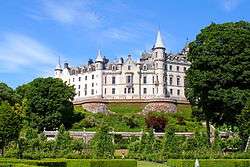Battle of Alltachuilain
| Battle of Alltachuilain | |||||||
|---|---|---|---|---|---|---|---|
| Part of the Scottish clan wars | |||||||
 Dunrobin Castle was besieged by both sides prior to the battle | |||||||
| |||||||
| Belligerents | |||||||
|
Clan Sutherland Clan Gordon (loyal to Elizabeth Sutherland and Adam Gordon) | Clan Sutherland (loyal to Alexander Sutherland) | ||||||
| Commanders and leaders | |||||||
|
Alexander Leslie of Kinninuvy John Moray of Aberscors | Alexander Sutherland, 1st of Killipheder | ||||||
| Strength | |||||||
| Unknown | Unknown | ||||||
| Casualties and losses | |||||||
| Unknown | All either slain or chased[1] | ||||||
The Battle of Alltachuilain[2] (or Ald-Quhillin[1]) was a Scottish clan battle that took place in 1518 or 1519 in the parish of Loth, county of Sutherland, Scotland.[1] It was fought between factions of the Clan Sutherland in a dispute over the Earldom of Sutherland.
Background
John de Moravia, 9th Earl of Sutherland (also known as John Sutherland), chief of Clan Sutherland died in 1514 leaving no heir. He was succeeded by his younger sister Elizabeth de Moravia, 10th Countess of Sutherland.[3] Elizabeth married Adam Gordon who was a younger son of George Gordon, 2nd Earl of Huntly, chief of the powerful Clan Gordon.[3] Elizabeth and Adam Gordon’s son, Alexander Gordon, Master of Sutherland, would become the legal heir to the Earldom of Sutherland, however this was disputed by others.[3] Firstly, John Mackay of Strathnaver, chief of the Clan Mackay rose up in opposition to the Gordons who had taken power in Sutherland.[3] Mackay fought against the forces of Elizabeth de Moravia and Adam Gordon at the Battle of Torran Dubh in 1517 where Mackay was defeated.[3] The Sutherland force had been led by Elizabeth’s younger half-brother Alexander Sutherland, who she had persuaded to resist Mackay.[3] However, shortly afterwards Alexander Sutherland married a sister of John Mackay,[3] and according to one account Mackay tampered with Alexander Sutherland to renew his claim to the Earldom.[4][5] Alexander Sutherland then claimed the Earldom of Sutherland for himself as the rightful heir.[1]
Sieges of Dunrobin Castle
According to the Gordon account, Adam Gordon offered Alexander Sutherland reasonable terms and conditions which he refused.[1] The clans and tribes of Sutherland then broke into factions and Alexander Sutherland had won great favour amongst them, having both the support of the Earl of Caithness and John Mackay, whose sister he had recently married.[4][1] While Adam Gordon was in Strathbogie (now known as Huntly, home of his family the Gordons of Huntly) Alexander Sutherland, with a great company of men, laid siege to Dunrobin Castle the principal seat of the Earls and Countesses of Sutherland, which he eventually succeeded in taking before Adam Gordon had returned.[1]
Adam Gordon then sent a force of his own under Alexander Leslie of Kinninuvy and John Moray of Aberscors to besiege Alexander Sutherland in Dunrobin Castle.[1] The castle surrendered,[5] however by this time Alexander Sutherland had retired into Strathnaver, the land of his brother-in-law John Mackay.[1]
Battle
According to the Gordon account Alexander Sutherland, with a new supply of men invaded Sutherland and killed some of his own Sutherland kinsmen because they supported Adam Gordon.[1] Alexander Sutherland then traveled further into the parishes of Clyne and Loth where, according to the Gordon account he molested the country.[1] Adam Gordon then sent Alexander Leslie and John Moray to "hold the bastard skirmishing" until he came with a larger force.[1] They met with Alexander Sutherland at a place called Alltachuilain[2] or Ald-Quhillin,[1] where there ensued a "hote skirmish".[1] Alexander Sutherland was taken prisoner and all of his men were either slain or chased.[1] He was then executed by Alexander Leslie at the very place where they fought, and his head placed on a spear on the top of Dunrobin Castle.[1]
Aftermath
In the aftermath of the Battle of Alltachuilain William Sutherland, 5th of Duffus would also claim the Earldom of Sutherland, however he was killed by the Bishop of Caithness in 1529.[6]
Adam Gordon and Elizabeth de Moravia’s son, Alexander Gordon became known as the Master of Sutherland, and his son succeeded as John Gordon, 11th Earl of Sutherland.[7]
Of Alexander Sutherland who was executed, his place of residence was known as "Kilphedder." His descendants occupied the lands for generations on payment of a nominal rent to the Earls of Sutherland. The ruins at Kilphedder now are more immediately connected with one of his descendants: William Sutherland of Kilphedder was a man of gigantic strength and stature who repaired and extended the residence of his ancestors.[2]
See also
References
- 1 2 3 4 5 6 7 8 9 10 11 12 13 14 15 16 Gordon, Sir Robert, A Genealogical History of the Earldom of Sutherland. Originally written between 1615 and 1630, published in 1813. pp. 95 – 97.
- 1 2 3 Sage A.M. , Rev. Donald (1899). Parish Life in the North of Scotland Chapter VI - The Topography of Kildonan - 1800. electricscotland.com. Retrieved on 29 December 2012.
- 1 2 3 4 5 6 7 Gordon, Sir Robert. A Genealogical History of the Earldom of Sutherland. Originally written between 1615 and 1630. Re-published in 1813. pp.75 -84.
- 1 2 Browne, James. (1875). A History of the Highlands and of the Highland Clans, Volume 1. pp. 181.
- 1 2 Sutherland Clan History. electricscotland.com. Retrieved on 2 January 2013.
- ↑ Mackay, Robert. (1829). History of the House and Clan of the Name MacKay. pp.100–106. Quoting: Gordon, Sir Robert. (1813). A Genealogical history of the Earldom of Sutherland.
- ↑ Gordon, Sir Robert. (1580–1657). A Genealogical History of the Earldom of Sutherland, (1813), pp.85-106.